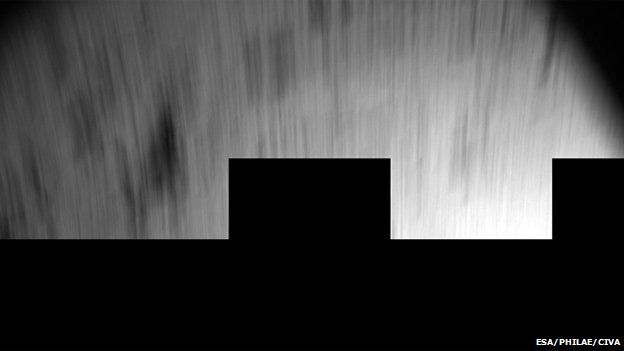Philae comet landing 'all a blur'
- Published

An image has been released that shows the hairy moment that the Philae comet lander bounced back into space.
The robot touched down on 4km-wide 67P/Churyumov-Gerasimenko in November, but not before rebounding twice.
The new picture is a big blur, which is not surprising given that the lander was far from static at the time.
It was acquired by Philae's CIVA camera system, which was primed to start shooting the moment the robot settled on to the surface.
"That image was a shock because obviously we were not still - we were moving," conceded co-principal investigator Jean-Pierre Bibring.
"It demonstrated together with [other data] that we were not on the comet.
"And at that time, it was terrible because we didn't know whether the ejection velocity was higher or lower than the escape velocity. So, we didn't know whether we would come back down to the surface."
Sharp images of the comet's terrain were eventually taken, but by then the robot had shot 1km across the comet and into a dark "ditch".
The shadowed hole drastically reduced the amount of sunlight reaching Philae's power generator, restricting its ability to charge its batteries.
As a result, the probe now lies dormant, waiting for better lighting conditions, which could arrive in the next few weeks as the comet moves into the inner-Solar System.
Reporters received an update on the mission here at the American Geophysical Union's Fall Meeting in San Francisco.
Prof Bibring also released a reprocessed CIVA image taken by Philae from its enclosed resting place.
This picture has been seen before, but the manipulation undertaken by scientists has revealed some new details.
Dubbed "Perihelion Cliff", it shows one of the walls next to the robot. Glare marks, the Frenchman said, were reflections from the lander.
Philae managed to despatch a good deal of science data from the surface before going into hibernation.
This information was successfully passed by the orbiting mothership, Rosetta, to Earth - and scientists continue to make their interpretations.
Meanwhile, the hunt goes on for Philae itself. Its precise location on the surface of 67P is unknown.
Rosetta took a series of pictures of the comet's surface on 12, 13 and 14 December. When these pictures are downlinked to Earth, researchers are hopeful they will find their lost probe.
It will be quite a task, however. There will be four million pixels in every picture and these will be scanned by eye for bright points that might betray Philae's presence.
"It sounds very difficult but the human eye is actually very good at doing this kind of thing," said Holger Sierks, the lead scientist on Rosetta's Osiris camera system.
Understanding precisely where Philae is on the comet will help engineers assess its predicament and the likelihood of an awakening.
Part of this work is already under way using the limited number of pictures sent back from CIVA.
A preliminary model of the final landing location and its difficult terrain has been constructed.
Prof Bibring remains confident he will hear from the robot again.
"We are in a shadowed place and the question is: when will the Sun be above the local horizon?
"It might be as early as January; it may be March. This we don't know yet because we don't know exactly where we are.
"If we know rapidly, we will make an assessment to see if we then have enough energy to re-boot the system and communicate."
Dr Matt Taylor, the Rosetta project scientist with the European Space Agency, whose venture this is, summed up the tension on the team: "It's a bit like waiting for Christmas presents."
Jonathan.Amos-INTERNET@bbc.co.uk and follow me on Twitter: @BBCAmos
- Published12 December 2014
- Published10 December 2014
- Published18 November 2014
- Published17 October 2014